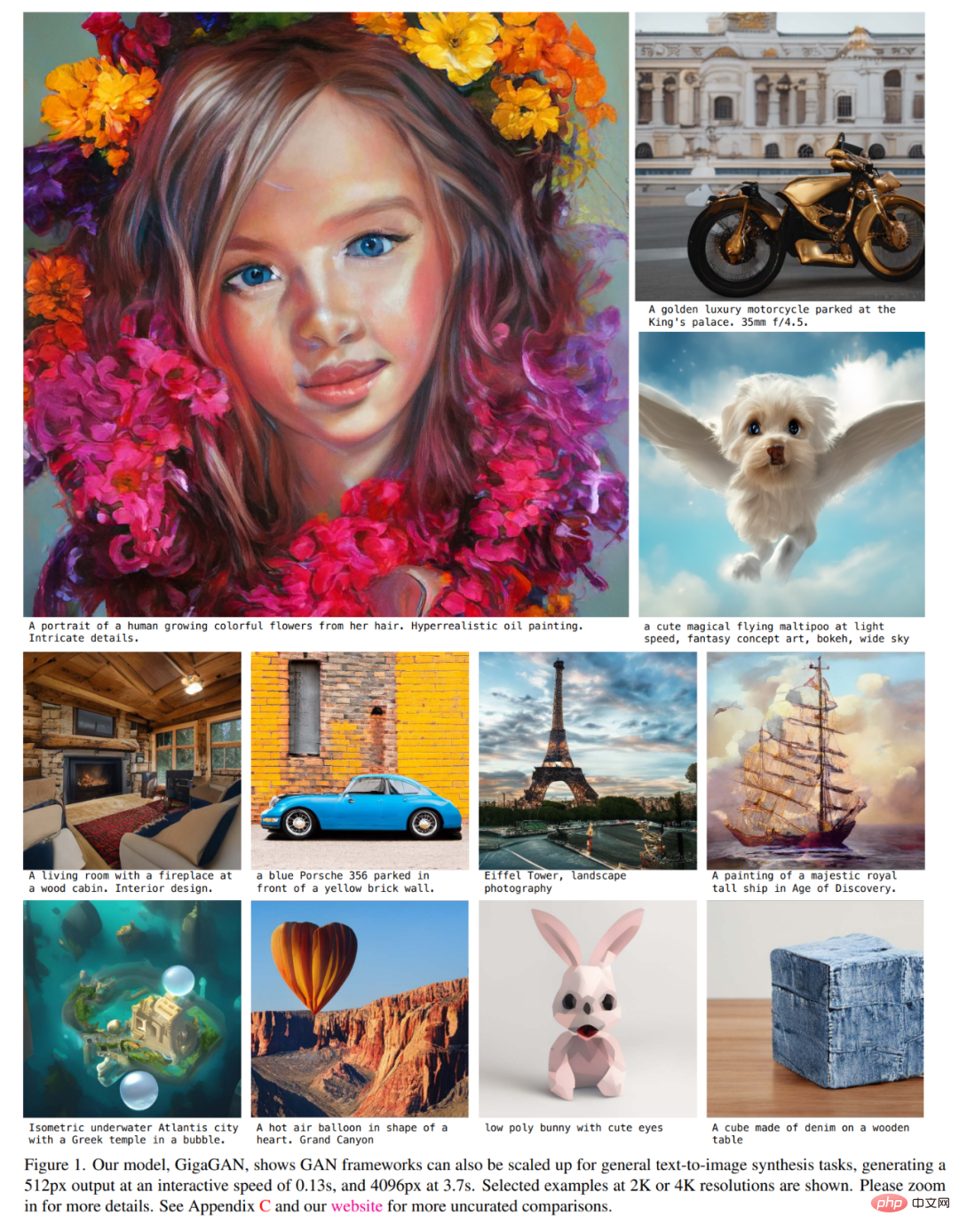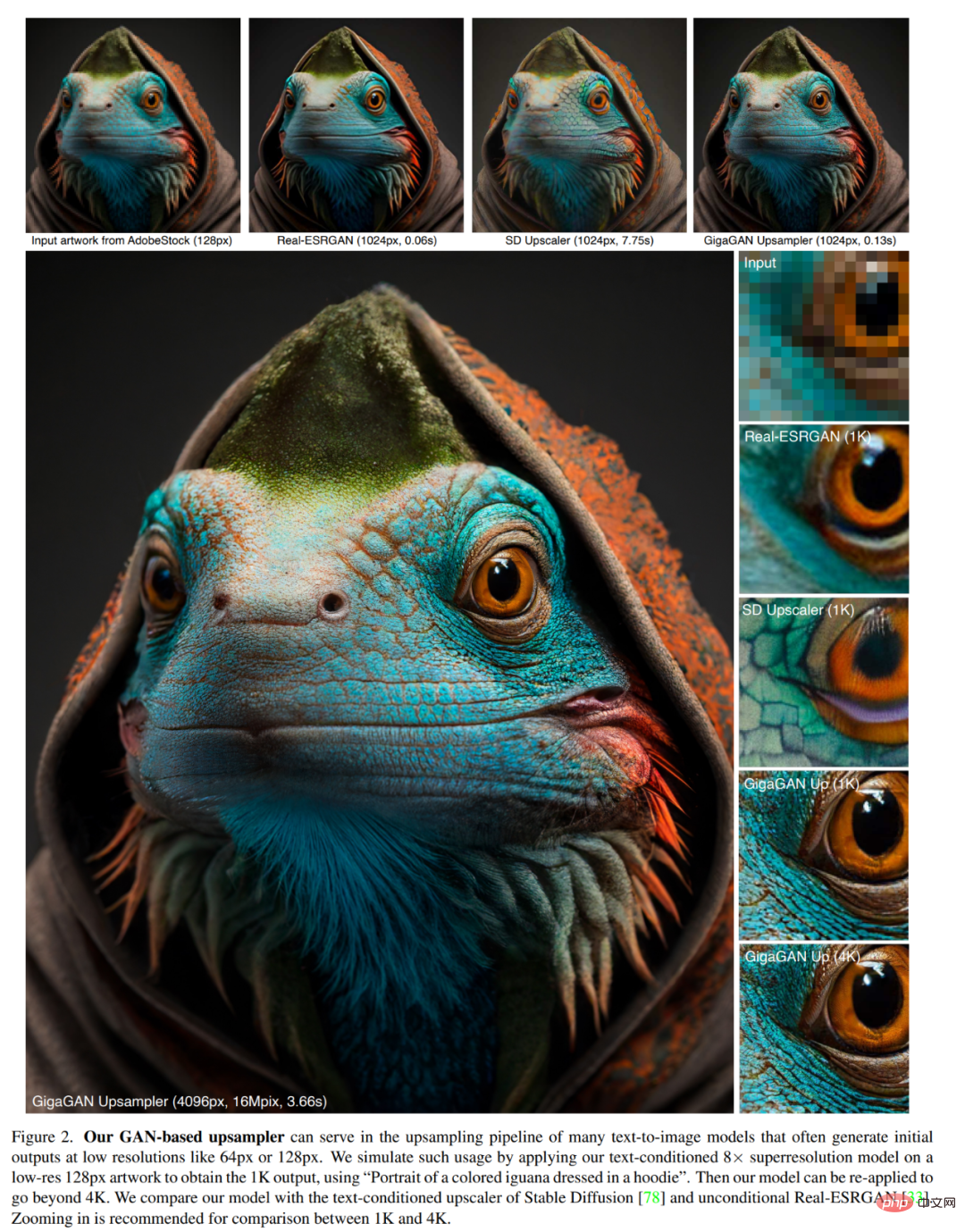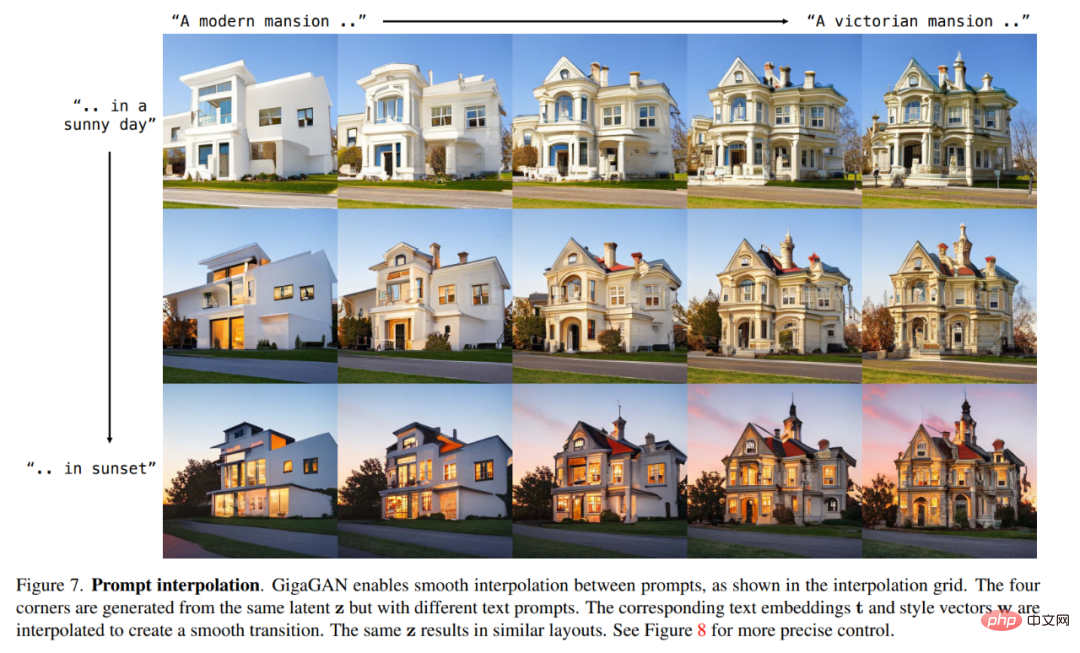
Image generation is one of the most popular directions in the current AIGC field. Recently released image generation models such as DALL・E 2, Imagen, Stable Diffusion, etc. have ushered in a new era of image generation, achieving unprecedented levels of image quality and model flexibility. The diffusion model has also become the dominant paradigm at present. However, diffusion models rely on iterative inference, which is a double-edged sword because iterative methods can achieve stable training with simple objectives, but the inference process requires high computational costs.
Before diffusion models, generative adversarial networks (GANs) were a commonly used infrastructure in image generation models. Compared to diffusion models, GANs generate images through a single forward pass and are therefore inherently more efficient, but due to the instability of the training process, scaling GANs requires careful tuning of network architecture and training factors. Therefore, GANs are good at modeling single or multiple object classes, but are extremely challenging to scale to complex data sets (let alone the real world). As a result, very large model, data, and computational resources are now dedicated to diffusion and autoregressive models.
But as an efficient generation method, many researchers have not completely abandoned the GAN method. For example, NVIDIA recently proposed the StyleGAN-T model; Hong Kong Chinese and others used GAN-based methods to generate smooth videos. These are further attempts by CV researchers on GAN.
Now, in a CVPR 2023 paper, researchers from POSTECH, Carnegie Mellon University, and Adobe Research jointly explored several important issues about GANs, including:

It is worth noting that Zhu Junyan, the main author of CycleGAN and winner of the 2018 ACM SIGGRAPH Best Doctoral Thesis Award, is the second author of this CVPR paper.
The study first conducted experiments using StyleGAN2 and observed that simply extending the backbone network resulted in unstable training. Based on this, the researchers identified several key issues and proposed a technique to stabilize training while increasing model capacity.
First, this study effectively expands the capacity of the generator by retaining a set of filters and employing sample-specific linear combinations. The study also adopted several techniques commonly used in diffusion context and confirmed that they bring similar benefits to GANs. For example, intertwining self-attention (image only) and cross-attention (image-text) with convolutional layers can improve model performance.
The research also reintroduces multi-scale training and proposes a new scheme to improve image-text alignment and generate low-frequency details of the output. Multi-scale training allows GAN-based generators to use parameters in low-resolution blocks more efficiently, resulting in better image-text alignment and image quality. After careful adjustment, this study proposes a new model GigaGAN with one billion parameters and achieves stable and scalable training on large datasets (such as LAION2B-en). The experimental results are shown in Figure 1 below.

In addition, this study also adopted a multi-stage method [14, 104], first with a low resolution of 64 × 64 The image is generated at 512 × 512 resolution and then upsampled to 512 × 512 resolution. Both networks are modular and powerful enough to be used in a plug-and-play manner.
This study demonstrates that text-conditioned GAN upsampling networks can be used as efficient and higher-quality upsamplers for underlying diffusion models, as shown in Figures 2 and 3 below.

The above improvements make GigaGAN far beyond previous GANs: 36 times larger than StyleGAN2 and 6 times larger than StyleGAN-XL and XMC-GAN . While GigaGAN's parameter count of one billion (1B) is still lower than that of recent large synthetic models such as Imagen (3.0B), DALL・E 2 (5.5B), and Parti (20B), the researchers say they have not yet observed any significant changes in the model's The quality of the size is saturated.
GigaGAN achieves a zero-sample FID of 9.09 on the COCO2014 dataset, which is lower than DALL・E 2, Parti-750M and Stable Diffusion.
In addition, compared with diffusion models and autoregressive models, GigaGAN has three major practical advantages. First, it is dozens of times faster, producing a 512-pixel image in 0.13 seconds (Figure 1). Second, it can synthesize ultra-high-resolution images at 4k resolution in just 3.66 seconds. Third, it has a controllable latent vector space that is suitable for well-studied controllable image synthesis applications, such as style blending (Figure 6), prompt interpolation (Figure 7), and prompt blending (Figure 8).


#This study successfully trained the GAN-based billion-parameter scale model GigaGAN on billions of real-world images. This suggests that GANs remain a viable option for text-to-image synthesis and that researchers should consider them for aggressive future expansion.
Method OverviewThe researcher trained a generator G (z, c), given a potential encoding z∼N (0, 1)∈R ^128 and text conditioning signal c, predict an image x∈R^(H×W×3). They use a discriminator D(x, c) to judge the authenticity of the generated images compared to samples in a training database D, which contains image-text pairs.
Although GANs can successfully generate realistic images on single- and multi-class datasets, open text conditional synthesis on Internet images still faces challenges. The researchers hypothesize that the current limitations stem from its reliance on convolutional layers. That is, the same convolutional filter is used to model a universal image synthesis function for all text conditions at all locations in the image, which is a challenge. In view of this, researchers try to inject more expressiveness into parameterization by dynamically selecting convolution filters based on input conditions and capturing long-range dependencies through attention mechanisms.
GigaGAN High Volume Text-Image Generator is shown in Figure 4 below. First, we use a pre-trained CLIP model and a learned encoder T to extract text embeddings. Feed local text descriptors to the generator using cross-attention. The global text descriptor, together with the latent code z, is fed into the style mapping network M to produce the style code w. The style code adjusts the main generator using the style from the paper - adaptive kernel selection, shown on the right.
The generator outputs an image pyramid by converting intermediate features into RGB images. To achieve higher capacity, we use multiple attention and convolutional layers at each scale (Appendix A2). They also used a separate upsampler model, which is not shown in this figure.

The discriminator consists of two branches for processing image and text conditioning t_D. The text branch handles text similarly to the generator (Figure 4). The image branch receives an image pyramid and makes independent predictions for each image scale. Furthermore, predictions are made at all subsequent scales in the downsampling layer, making it a multi-scale input, multi-scale output (MS-I/O) discriminator.
 Experimental results
Experimental results
In the paper, the author recorded five different experiments.
In the first experiment, they demonstrated the effectiveness of the proposed method by incorporating each technical component one by one.

In the second experiment, they tested the model’s ability to generate graphs, and the results showed that GigaGAN performed better than Stable Diffusion (SD-v1.5) is comparable to FID while producing results much faster than diffusion or autoregressive models.

In the third experiment, they compared GigaGAN with a distillation-based diffusion model, and the results showed that GigaGAN was more efficient than distillation-based diffusion. Models synthesize higher quality images faster.

In the fourth experiment, they verified that GigaGAN’s upsampler achieved conditional and unconditional super-resolution. Advantages over other upsamplers in rate tasks.


##Finally, they presented their Large-scale GAN models still enjoy the continuous and disentangled latent space operations of GAN, thus enabling new image editing modes. See Figures 6 and 8 above for diagrams.
The above is the detailed content of GAN's counterattack: Zhu Junyan's new CVPR work GigaGAN, the image output speed beats Stable Diffusion. For more information, please follow other related articles on the PHP Chinese website!
 Convert text to numeric value
Convert text to numeric value
 What is the difference between legacy and uefi?
What is the difference between legacy and uefi?
 Introduction to the location of win10 control panel
Introduction to the location of win10 control panel
 How to modify the text on the picture
How to modify the text on the picture
 How to recover permanently deleted files on computer
How to recover permanently deleted files on computer
 Delete search history
Delete search history
 What file is .exe
What file is .exe
 Why do the words after typing in word disappear?
Why do the words after typing in word disappear?




